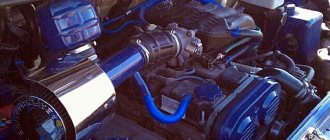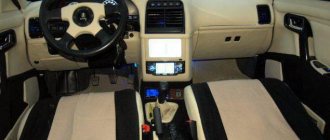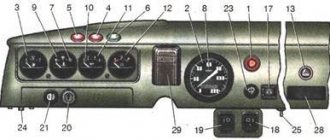Technical tuning of the Gazelle
Among supporters of the technical improvement of the Gazelle, only a few advocate a radical re-equipment of the car. At the same time, as a rule, there is no talk about remaking the engine - although citizens who have such an opportunity replace the standard GAZ unit with a Japanese-made engine + automatic transmission.
Such an operation is effective, but expensive and complex, and requires the involvement of third-party specialists. We are talking about tuning the Gazelle with our own hands, so we are talking about an even more modest scale. And there is no particular need for physical alteration of Gazelle engines.
But gear shifting needs to be dealt with decisively and irrevocably! The standard manual transmission of the car works flawlessly, but the long lever with its eternal tendency to uncontrollable rattling and a gradual increase in the amplitude of movements should be changed.
Installing a neat joystick is not difficult. Moreover, the cable gear selector has become a standard feature of the latest models of GAZ minibus.
If you are tuning an onboard Gazelle, there is a high probability that you will need to increase the vehicle's carrying capacity. In addition to the mandatory frame reinforcement (see https://www.autodela.ru/main/top/diy/tuning_uaz_3303), it is useful to equip the car with air suspension with electronic level control.
Installing air springs is preferable to reinforcing the springs with additional sheets. Increasing the stiffness of the suspension by increasing the thickness of the springs significantly changes the behavior of the car on the road. An unloaded Gazelle with overly stiff springs begins to “goat” on potholes.
The method of impact-sledgehammer re-pressing of additional spring leaves, common in the practice of amateur tuning of Gazelles, leads to the formation of areas of microscopic cracking of the metal - which ultimately results in damage to the springs at maximum vehicle load. Bending springs without preheating the metal means breaking the product!
An ingenious way to increase the capacity of the body of an old Gazelle is to install an additional rear axle. The third axle is mounted behind the drive wheels, and is a standard rear axle, disconnected from the drive and completely devoid of the gear filling of the gearbox.
The most proactive car owners make the third lifting axle. The most advanced ones connect an additional axle to the cardan transmission - but only if they have an economical diesel engine rumbling under the Gazelle hood. Otherwise you only have to carry gasoline...
On the Internet you can find materials about installing powerful engines from high-speed passenger cars on Gazelle (fortunately, there are a dime a dozen at dismantling sites for such units). The economic efficiency of such an event is negligible - although purchasing a used motor does allow you to save money.
The operating parameters of high-speed power units are of little applicability to both cargo and passenger Gazelle. The result of forced “hybridization” of a car is usually increased wear of the transmission, excessive fuel consumption, and accelerated carbon formation in the piston group of the engine.
Choosing Tires: Affordable or Energy Efficient?
Tires are another cost item for motor carriers. When every ruble counts, the question of what to “shoe” the fleet is not at all cheap.
Using cheap tires can cut your costs by 50% - simply because they are cheap. In the overall cost structure, spending on tires takes up only 1%. But the mileage until the next replacement will be reduced, and fuel consumption will increase. Thus, having saved 0.5% of the total cost of owning a company (let’s take this value as ₽500 thousand), you can lose up to 5% (i.e. up to ₽5 million) due to increased fuel consumption and the need for more frequent tire replacement.
Let's consider the effectiveness of energy-saving tires using the example of a new range of truck tires. Michelin developed them with an ambitious goal: to ensure that fleets get real fuel savings without sacrificing the usual mileage and handling values. The company's engineers combined the most modern technologies and rubber compounds.
How much can you save with energy-efficient tires?
In this case, replacement will occur gradually as the old sets of tires wear out. This practice will reduce one-time costs, and the savings will increase until they reach truly tangible values.
How much money will energy-efficient tires save your company?
Calculate your benefit using .
Tuning the engine cooling system
Which of the “gazelists” is not aware of the problem of summer heat? An engine heated to its operating maximum cannot be turned off: it boils! Moreover: in many cases, natural wear and tear of the engine also entails a decrease in the performance of the cooling system, as a result of which boiling can occur not only when turning off a hot engine, but even when switching from high speeds to idle.
Among the proposed solutions, the engineering service of the Avtodela magazine seems optimal to install an additional temperature sensor in the area of the lower pipe. The fan that ensures air movement through the radiator honeycombs must in this case have an electric drive.
A certain number of alterations are required when leaving the standard fan unchanged (with a belt drive) and installing an additional fan between the radiator and the body radiator grille. Placing two fans in the same working plane looks much more elegant. In the photo of the Gazelle tuning you can see the details of such a modification.
An expensive but very effective method of improving the cooling system of an old-style Gazelle engine is to replace the standard radiator with a copper one. A half action is also practiced: installing an additional copper heat exchanger with connecting the device to the lower and upper pipes.
However, installing a factory-made or home-made coil from a copper tube in front of the radiator can ruin the matter. The deterioration of the cooling system occurs due to a decrease in the intensity of the air flow passing through the honeycombs.
Power plant modernization
Tuning the power plant is performed primarily for one of two purposes:
- increasing vehicle efficiency;
- improvement of dynamic and traction characteristics.
The safest and easiest way to achieve one of the above goals is chip tuning. Its main advantage is that if the ECU flashing fails, it is always possible to return to the factory settings. The cost of chip tuning starts from 2 thousand rubles. The disadvantage of this modernization is only a slight change in the characteristics of the motor.
Another option for engine tuning is replacing some components and parts. The most popular option is to install a zero-resistance air filter and a direct-flow exhaust system. The cost of such upgrades starts from 2 thousand rubles.
A more complex tuning is to rebuild the engine using stock spare parts. In this way, engine performance can be significantly influenced. The cost of the bulkhead starts from 30 thousand rubles.
A radical way to tune an engine is to install an engine from another car. The most popular for these purposes are power units from Japanese minibuses and SUVs. The cost of a swap starts from 120 thousand rubles.
Chip tuning: useful additives to engine productivity
Chip tuning is necessary for a gazelle engine to the same extent as any other internal combustion engine needs it. The main aspects of chip tuning are covered in the article on the page https://www.autodela.ru/main/top/diy/chip_tuning. According to reviews from car owners, Gazelle chip tuning allows you to:
— make the speed increase fast and smooth, without failures or failures;
— eliminate the effect of “floating” speed in all speed ranges;
— increase traction during the acceleration phase.
Don’t expect a noticeable reduction in fuel consumption from Gazelle chip tuning. But you will certainly feel an increase in throttle response and torque!
Fuel economy: strict control or employee motivation?
For the transport business it is a cornerstone. It's no secret that about 50% of carriers' expenses come from fuel. There are several ways to reduce these costs, and it is better to implement them comprehensively: install monitoring systems, train drivers to drive economically and encourage them to use the acquired knowledge by introducing a reward system.
Telematics will help control fuel consumption and provide objective information. This data will become the basis for optimizing fuel costs. Monitoring systems will also influence the discipline of drivers, who will know that every liter of diesel fuel counts.
How much can you save by implementing telematics?
But simply equipping a vehicle fleet with telematics is not enough. Fuel consumption is highly dependent on driving style, and many drivers fail to improve their performance without knowing about simple and effective saving methods. Therefore, driver training is an equally important part of optimization, which will improve their professional training and will definitely pay off in the future.
Tuning the Gazelle's interior
The three of us in the cabin of the on-board Gazelle are frankly a bit cramped. But if you convert the right sofa into a single chair and forget about the second passenger, it will turn out luxurious. The Gazelle's interior is covered in white leather to enhance the feeling of luxury.
The “gentleman’s kit” for tuning the Gazelle’s interior usually includes:
— equipping the doors with electric window lifts;
— replacing the standard heater with a more efficient one;
— installation of ergonomic seats;
— installation of audiovisual equipment;
— production of a ceiling console (or shelf);
— alteration of the dashboard with installation of an on-board computer.
Reconstructing the drive of the sliding windows is simple and does not cause difficulties even for a novice gazelle driver. Heating is being improved in two ways. The first way is to replace the fan and radiator with more efficient devices; the second way is to install (usually under the passenger seat) an additional stove, preferably an autonomous one.
The ceiling console is used to accommodate non-standard electronics, speakers, and lighting fixtures. It has been found out experimentally: using a homemade ceiling shelf for transporting all sorts of small items sooner or later turns into a useful addition to the bomb bay. Don't go wrong with your choice!
Headlights and lighting
The lighting efficiency can be increased, thereby achieving better visibility at night and increasing vehicle safety.
Options for improving the light are as follows:
- Equipping the vehicle with additional devices. They will be placed on the cabin, fairing, hood and bumper. The fastening is done internal or external, depending on the design of these parts.
- Replacing standard products with more powerful ones. To do this, you will have to carry out a number of manipulations on the front of the car. To create a hole of the desired shape, fiberglass and epoxy glue are used.
If the external design of the car suits its owner, then the luminosity of the headlights is restored.
To do this, the following manipulations are performed:
- The products are removed from the fastenings. They are cleaned of dust and dirt and their condition is checked. Minor repairs are carried out if necessary.
- The glass diffusers are polished until smooth. This will return them to their original transparency, remove chips and scratches that refract the lamp beam.
- The reflectors are puttied, sanded and covered with special foil. All irregularities are eliminated and air bubbles are expelled.
- Refurbished headlights are installed in sockets. Compact LED lamps are inserted into them. The assembled products are sealed.
For basic lighting, it is better to use fluorescent lamps that highlight the entire interior well. LED strip lighting is mounted on doors, steps, shelves and drawers. Power is supplied from the battery. Switching on is done automatically or from a button.
GAZelle tuning: how not to lose face
The ambitious goals of auto tuning are not an excuse for those who do not improve, but worsen. What not to do? Like this!
You can only move in such a car very slowly and away from other transport. And such a design will not last long - unless a steel plate as thick as an arm is hidden under the bottom of the body.
The desire for stylistic unity of a house, a car and an old wagon left over from a gypsy grandfather can play a cruel joke on the owner of a Gazelle. Bright rags, golden fringe, pennants on the windshield, patterns on the windows... They say half of India and all of Pakistan drive like this. But where is India and where are we? With such tuning of the Gazelle, you won’t get far in our country, and not only because of the indignation of the traffic police inspectors.
Swivel seats are a great idea! The car doesn't always move, does it? It’s better to communicate face to face while parked! The main thing is the reliability of fixing the seats in the selected position. Otherwise, turns on the road will have to be carried out in two steps: the first is to rotate the steering wheel; the second is to return the chair to its original position.
Flocking of body surfaces is either becoming fashionable or will never go out of fashion... Any fleecy material is an unsurpassed dust accumulator and an inexhaustible source of fibrous deposits, but this is not enough. Flocking is a great way to paint your cabin in eye-catching contrasting colors. No one would want to drive such a car!
Reworking the Gazelle body
The high body of the covered cargo Gazelle is both good and bad. An increase in aerodynamic drag leads to a sharp increase in fuel consumption. A fairing mounted above the cabin can improve streamlining. But only if its size and shape are adequate to the geometric parameters of the car. Errors in choosing the shape of the fairing cannot be compensated for by installing additional headlights.
It's no better if the usefulness of the original idea is drowned in layers of pseudo-improvements. Additional air intakes on the hood and above the hood; visor over the windshield; embossed bumper for Gazelle; the lower side body kit is nothing more than banal excesses.
And even the incredible light tuning of the Gazelle does not improve matters. Such a car is noticeable, looks catchy - especially in the dark - but is not beautiful. And for an impressionable pedestrian, it’s a completely horned messenger of the underworld...
Gazelle is a big car. It would seem that nothing prevents it from being used as an object for artistic experiments of any scale. But not everything is so simple...
Enlarged rims, infernally shining disc brakes, a maxi-skirted body kit, a stenciled dragon on the side... Visually, the car sat down and rushed off. But even on the smooth roads of the airfield, you can only drive it in the summer, exclusively in windless, dry weather.
A fur coat suits a car, you’ll agree! We bring to your attention a very feminine tuning of the Gazelle, and even with an emphasis on the ever-fashionable leopard motifs. As they say in medically insurmountable cases - “stylish, sweet, gentle, touching.” And probably not cheap. It’s also profitable if you follow this cat’s Gazelle and take bets from gambling passers-by on the rate of corrosion of fur-covered metal.
A long car rides smoother, it has plenty of space inside... But! If you weld (even in a factory setting) two standard Gazelle bodies together, be prepared for the rapid appearance of cracks in the most unexpected places. Yes, and in the expected ones too.
Any box-shaped structure is unstable to torsion, and all artisanal attempts to strengthen and secure the body by welding gussets, ties, reinforcements and other weighting agents are ineffective. But it looks impressive, no doubt!











